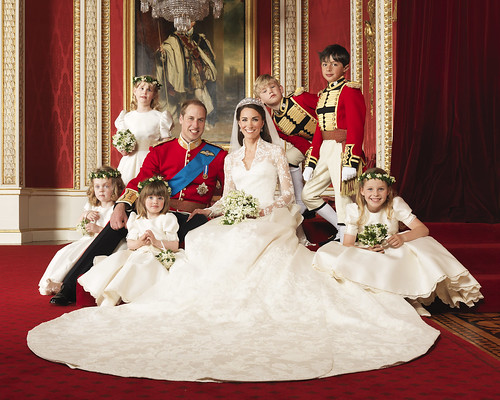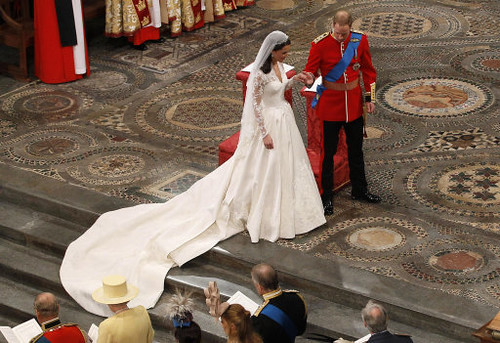As everyone else is blogging about the royal wedding, I thought I'd get my tuppenceworth in. I hadn't intended to get caught up in it but I found myself absorbed in the spectacle and more interested than I'd expected in seeing this lad we've seen grow up get married. Perhaps those of us old enough to remember the 1981 wedding when we were all a bit less cynical felt a bit of a link that transcended politics or anger, or even logic. Maybe we needed to right the balance after wasting so much excitement 30 years ago on something that turned out to be so empty.
But, this is a blog primarily about the clothes.
I thought the dress was perfect. Perfect for her, the occasion, the venue. A wedding dress is all context and all about the bride and a designer should be chosen to fit with what the bride wants. In that respect the house of Alexander McQueen with it's pedigree of the unconventional, might seem to be a curious choice for Kate Middleton, who has always demonstrated fairly conservative tastes. But it isn't really. Firstly it had to be a British design house, and it had to be a designer able to offer impact, structure, detail and quality of the highest degree. All things Sarah Burton at Alexander McQueen could do in spadeloads. It also had to ideally be a design house with a respect and knowledge of heritage and tradition, again McQueen fits the brief.
So the results; was the dress groundbreaking? No. Was it high fashion with a capital H? Again, no. This was not the place for that, nor was it the bride for that. An in-your-face, divisive dress would've been totally inappropriate. It was however beautifully cut and crafted with layers of fabulous understated detail. It had structure and enough volume to dominate the space without being a puffball or dominating her. I think lots of people expected her to go for something sleek and modern, perhaps more like Pippa's maid of honour dress. But in the setting of Westminster she needed more visibility and scale so that was never going to happen. It also referenced the past beautifully, with nods to Grace Kelly's famous lace sleeved wedding dress and also Princess Margaret's and even the Queen's wedding dresses. A nice touch to link to the past, and most visibly to a another non-aristocratic and high profile bride such as Grace Kelly. Yet the cut of the skirt and train had that flash of McQueen brilliance (and of course lace is very current) All in all, the detailed handmade lace, the top quality fabrics, the exquisite cut and a design which perfectly suited the woman and allowed her to shine, enhanced by the subtlety of the designers vision rather than drowned in fashion ego - meant this was truly a couture bridal gown.
I also want to bang a regular drum of mine. I have read so many compliments on her posture and her tiny waist. Some people don't seem aware that the gown was corsetted.
To quote the official website: The ivory satin bodice, which is narrowed at the waist and padded at the hips, draws on the Victorian tradition of corsetry and is a hallmark of Alexander McQueen’s designs.
Now clearly the extremely slender Catherine does not require any reduction, however the lines of the dress worked so well because of the structure. So many women hanker after the gorgeous gowns from the golden age of Hollywood, drool over historic costume and lust after the New Look fashions of the 40s and early 50s. Yet, when they try to recreate the look it very often just doesn't quite work. That's because dresses today mostly lack the internal structure those dresses had, and nobody suggests a corset as an alernative. Or, if there is structure it's poor quality plastic boning that stabs and twists and results in the wearer, understandably, writing off everything boned as uncomfortable. If you want that firm shape and cinched waist, the perfectly hanging skirt and just the 'right' shape then a properly fitted corset is what you need. I shall get off that soapbox now... but I warn you, I'll be back on it.







I totally agree with you re the foundations aspect .. people don't seem to realise that all women - regardless of shape or size wore very firm foundations right through the 50s/60s .. Even the waif like Audrey Hepburn wore corsetted dresses and gowns and today, couture houses still depend on corset technology to achieve that smooth and flawless finish. I guess we are biased though ;) Great post.
ReplyDeleteHey! you need to get the facebook "like" button on ur blog!
ReplyDeleteAnyways, although we have disagreed on the style factor, i totally agree about the corset and underpinnings aspect. Your undergarments are probably the most important bit of your outfit, weather your a skinny model or a size 18 average. Thats one of the reasons woman traditionally take so very long to get ready before leaving the house; all of those laces and layers.
xoxo LLM
Spot on Ali! I feel the only thing which could have been improved was her veil - a wee bit too flat for me, could have been lifted off her hair and face slightly. But a small point. Xx
ReplyDeleteJulia, we're certainly biased :) Yes, I think it's very obvious when you know but I've seen umpteen comments suggesting it isn't to others. And you only have to look at a red carpet to spot where the corsetry is missing. where you spot just how not obvious it is to many is on 50s style bridal gowns. They so often miss the mark of achieving the right silhouette, and of course that's why.
ReplyDeleteLaura, I'm a bit funny about too much linking up over social networks. I'll look into it though.
Linda, I know. I couldn't decide whether I liked that or not. The veil was a bit 1920s/30s yet the dress had more nods to the 40s and 50s which bothered me a little.